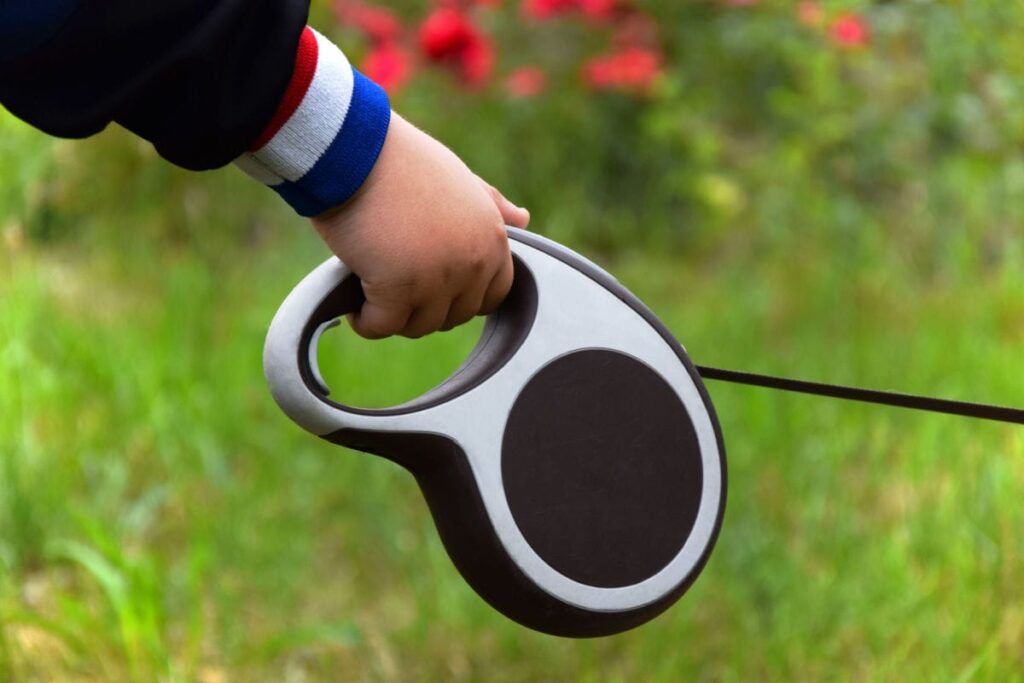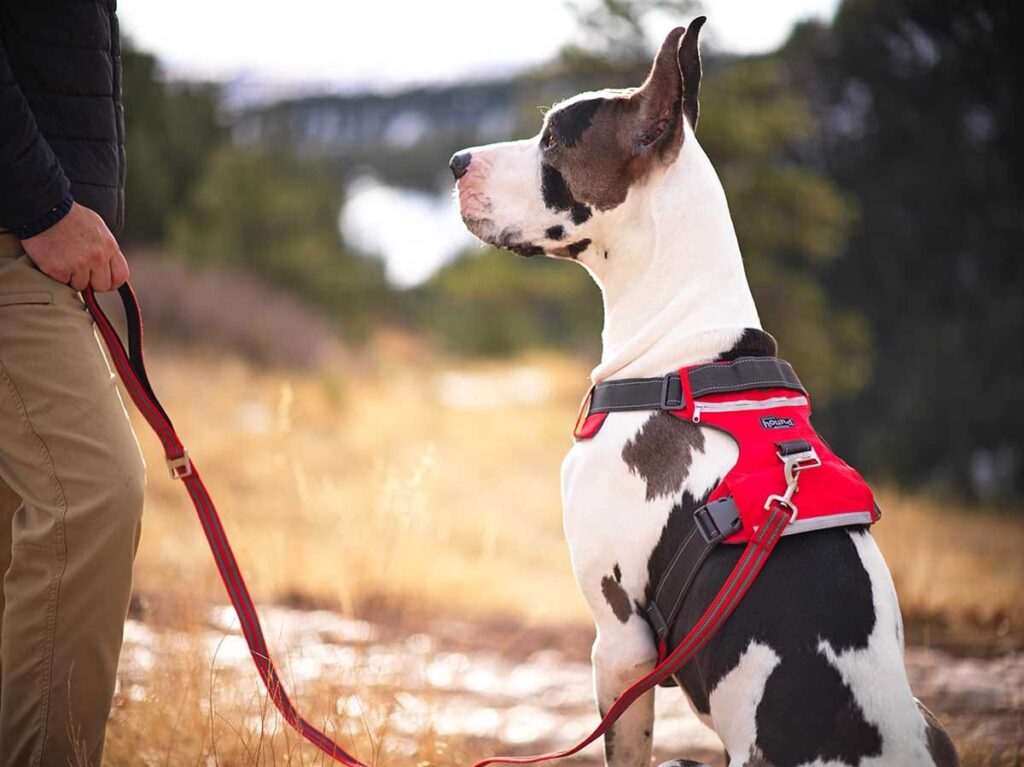If you have an energetic dog, you might think a retractable leash would be a good idea. After all, the leash will give your dog some room to roam ahead of you. If your dog pulls on a regular leash, you won’t have that problem.
While it might be more convenient for dog training, there are problems that retractable leashes pose that loving pet parents might not be aware of. In fact, the dangers of retractable leashes and the negative behavior they can encourage in your dog may outweigh the convenience factor.
Let’s take a closer look at why retractable leashes can cause a number of dangerous situations for your best friend. According to Preventative Vet, there are a lot of reasons why you don’t want to use retractable leads.
Problems Retractable Leashes Cause for Your Dog Training

Flexi-leashes, as retractable leashes are also known, are always adding tension to your dog’s leash. When you’re training your dog, you actually want him to learn to engage in loose leash walking. This means you want him to walk with you so that there is some slack on the leash.
With traditional leash training, the tension in the leash should signal your dog that you’re changing directions or that he has reached the end of his forward motion. If your dog is constantly walking with tension on the leash, he’s not going to pick up on those signals. In fact, he may learn the opposite.
If you’re leash training a puppy, the constant tension on the leash cord of a Flexi-leash also prevents them from learning proper leash manners. It’s particularly important to start them out on a flat leash until they learn those manners. If you’ve already started them on a retractable leash, you can simply change them back to a regular leash.
When teaching them leash manners, many professional dog trainers will not allow retractable leashes in their group classes. They are more difficult for humans to handle, and it makes it harder for students to keep their dog at a safe distance from other members of the group. That can result in a dog fight and even more problems for you and the dog trainer.
For all these reasons, it’s just a better idea to stick to traditional leashes when working with untrained dogs.
Leash Handling Is More Difficult with Retractable Leashes

A big part of the problem with retractable leashes is that they are more difficult for humans to handle. The handle and leash storage mechanism for the leash is bulky.
Many people have problems untangling the leash if their dog wraps it around something or someone, and transferring the leash between their hands is more difficult too.
It’s important to remember that a leash is a communication tool that you use so you can signal your dog. Particularly if you have a large dog or a strong, aggressive dog, you might need two hands to signal them. That’s hard to do with a retractable leash.
Additionally, if you are walking two dogs, retractable leashes make leash handling almost impossible. You can’t really provide the feedback you need through a retractable leash, so it’s much better to use regular leashes in this case.
These leash handling problems with a retractable dog leash can cause serious injuries.
Common retractable leash injuries include:
- rope burn
- cuts
- finger amputation
- broken bones
- eye and face injuries
- shoulder, throat, and neck injuries
Let’s take a closer look at some common injuries they can cause.
Serious Injuries Retractable Leashes Can Cause

There are a number of different injuries that retractable leashes can cause. These can be serious, and they are not limited to your dog. You can be injured too.
Burns and Cuts
If you get your fingers or hands tangled up in the retractable lead, it’s easy for your dog to pull on it and cause a kind of rope burn, road rash, or cut in your fingers or hand. This could also happen to the dog on the leash or another dog who gets tangled in the lead.
Finger Amputations & Broken Bones
Depending on your dog’s size and strength, if your fingers are wrapped around the strong, thin cord of the retractable lead, he could jerk on it hard enough to cut a part of your finger right off. Similarly, he might pull on it in such a way that it breaks your bones.
This could also happen to your dog or other dogs who get tangled up in the lead as well. It’s a strong cord and can provide enough leverage to cause broken bones and other serious injuries.
Injuries to Eyes and Face
Sometimes, the plastic handle or metal clip of a retractable lead can break. If that happens, the lead can recoil out of control and hit you or your dog in the face. Either of you could suffer serious injuries to your eyes.
In other words, words you probably have heard from your mother, “You’ll put your eye out!” I jest, but it’s really no laughing matter.
Shoulder, Throat, or Neck Injuries
Because retractable leashes have a long ‘runway,’ they provide your dog the opportunity to really get moving when he sees something that captures his interest, like a squirrel. He can lunge so fast that when he reaches the end of the leash, he gets a strong jolt that can put a lot of stress on his neck and throat. This can cause serious damamge to the trachea.
Likewise, you can injure your shoulder because of that strong jolt. If you let go to avoid injuring yourself or your dog, now your dog is running around off-leash. Either way, it’s a problem.
Other Safety Risks with Retractable Leashes

There are some other types of risk posed by Flexi-leashes as well. Because your dog can get so far ahead of you, if your attention wanders at all, he could get into trouble quickly. He might run out into traffic or come face-to-face with an aggressive dog.
If drop the leash, he might also bolt, and now he’s running around with a retractable lead and a bulky handle. That can put him in some dangerous situations if he runs out into traffic or other environmental risks.
For example, the long leash could get tangled up or caught on branches, wrapped around a tree, or caught on a rock or other obstacle. Getting caught like that can present a serious threat to your dog’s health and life.
Are Retractable Leashes Ever Good?
There may be some cases where retractable leashes can be a good choice. If you have a well-trained dog who has already learned to walk on a loose leash and who you know will come back when you call, a retractable leash might be a good choice.
Additionally, it might be fine to use a retractable leash on a small dog or when you’re somewhere you know you won’t encounter other people or dogs. Still, you have to consider that there can be environmental hazards that could create a problem.
When Should You Never Use a Retractable Leash?

First, you should never allow a child to use a retractable leash. There are just too many potential risks, and it’s not worth it.
You also shouldn’t use this kind of lead when you are near hazards, like traffic, or in busy places with lots of people and other animals, like a dog park.
Do not use a Flexi-leash for dog walking if your dog has a pre-existing back or neck injury, and you shouldn’t use them if you use any kind of aversive collar like a choke collar. You also shouldn’t use them with a dog that is stronger than you.
Another situation where you don’t want to use these types of leashes if you are walking more than one dog. Finally, don’t use them if you use a head halter, like a Gentle Leader or Halti, or if you are going into an elevator with your dog.
What Kind of Leash Should You Use?

There are some great traditional leash alternatives to retractable leashes at pet stores, and they come in a variety of lengths, depending on what you’re doing with your dog. If you’re walking your dog in a busy environment or at a training class, you can use a 4 or 6-foot leash.
If you’re out hiking or engaging in recall practice to get your dog to come when you call, you can use a 10-foot-long leash. For city dwellers or in other situations where you want to keep your best friend on a short leash, you can choose a 2-foot traffic leash.
Shorter leashes let you keep better control over your dog, but you can choose something like a 6-foot-long leash and get a traffic handle addition for it to shorten it when you need that.
Final Thoughts

While retractable leashes might seem like a good alternative for loving dog owners who want to give their fur babies a little more room to run, they are really not worth the risk they cause to you and your dog. It’s better to go with a traditional leash or choose a few of varying lengths so that you can give your best friend more room to roam in those situations where it is appropriate.
In all situations, you want to ensure your dog gets the proper loose leash training so that he knows his leash manners. It will make your life and his a whole lot easier!

